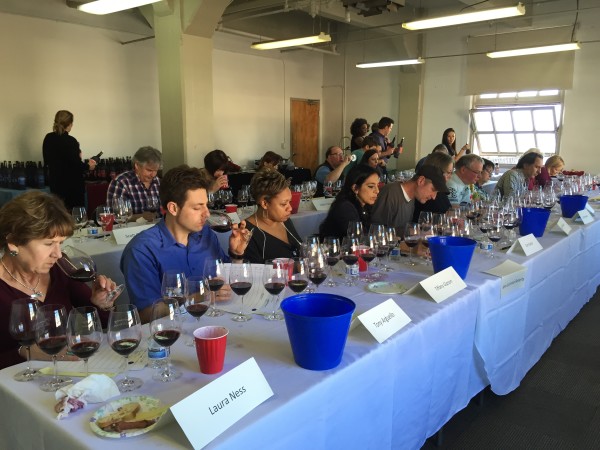
Judging at the Cabernet Shootout Finals
I recently judged the 9th annual Cabernet Shootout, organized by Barbara Drady of Affairs of the Vine. 397 Cabernet Sauvignons, Cabernet Francs and Cabernet blends were entered. They came from 15 California AVAs, as well as 21 other appellations spread across Oregon, Ohio, New York, Virginia, Western Australia and South Australia.
The professional judging panels were made up of 22 men and 18 women. Each wine was tasted twice. All tastings were blind, with no regard to price, origin or vintage. Each panel judged only 32 wines per day, to ensure against palate fatigue. As usual, price was no indicator of quality. The most expensive was $145, the least was $12.
The results of the Shootouts are unique in being divided by gender. Further, after the professional judges make their pronouncements, the 32 highest rated wines are sent to the Cabernet Shootout Challenge, an event where consumers, wine trade and media are invited to test their palates against the judges. 162 of the attendees took up the challenge. Again, the results were divided by gender. For the full results, go to www.AffairsoftheVine.com. What I found most interesting on a personal level was that 3 of my top 13 wines were in the top 3 of the women’s professional judging panel, and a fourth was in the top 3 of the women’s consumer judging panel, while not one of the men’s top 3, in either the judges’ or consumer panels, ended up in my top 13. I take this to indicate that I appreciate finesse and nuance of flavor (I’ll pause here strut my male ego and fluff my feathers, thank you very much).
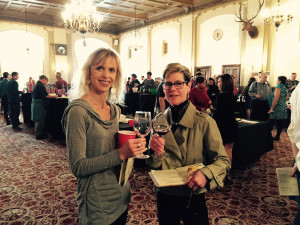
Kristen Austin and Susan Darwin take the Cabernet Shootout Challenge
Here are my favorites:
Cabernet blends:
 Penman Springs Vineyard, 2011, Paso Robles, Artisan Cuvee:
Penman Springs Vineyard, 2011, Paso Robles, Artisan Cuvee:
The French oak overtones, which lend layers of vanilla and nutmeg, are matched by deep, plummy fruit. Chalky tannins and vibrant acidity give the wine a firm, classic structure. Fine balance and length. Only 258 cases produced. $28.
94 points.
Calcareous Vineyard, 2011, Paso Robles, Lloyd:
A medium-bodied wine with a nose of cherry and nutmeg. Smooth texture, lots of oak but fully integrated with the fruit which comes off as cherry-pomegranate on the palate. Long, elegant finish. 480 cases produced. $50.
93 points.
Cliff Creek Cellars, 2009 Sams Valley Vineyard, Southern Oregon Claret:
Though I don’t have the exact percentage of the blend, it will be approximately 40% each of Cabernet Franc and Cabernet Sauvignon, and 20% Merlot. This is the most Bordeaux-like of the group, with a cassis nose (black currant, tobacco leaf), tight classical structure, and subtle dried fruit notes on the palate. Lightly astringent, with light earthy notes in the finish. Note: though a 2009, it’s just being released in April, 2015. 771 cases produced. $25.
92 points.
 Peterson Winery 2010 Agraria, Bradford Mountain Estate, Dry Creek Valley, Sonoma County, Big Barn Red:
Peterson Winery 2010 Agraria, Bradford Mountain Estate, Dry Creek Valley, Sonoma County, Big Barn Red:
77% Cabernet Franc, 8% Cabernet Sauvignon, 6% Petit Verdot, 5% Merlot, 4% Malbec. Blackberry with a strong herbal background on the nose. The palate displays raspberry with herbs, green olives and cocoa powder, tart acidity, chalky tannins, and a vibrant finish. It tastes balanced, but at 14.8% alcohol you might want to imbibe judiciously. 100 cases produced, $60.
91 points
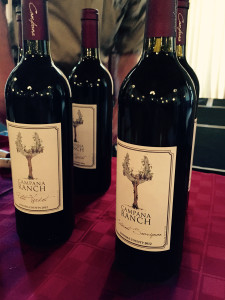 Campana Ranch, 2012 Sonoma County, California Cuvee:
Campana Ranch, 2012 Sonoma County, California Cuvee:
This is the first vintage for Campana Ranch winery. I tasted it on two separate occasions, both times giving it 90 points. I found light herbal notes under Boysenberry fruit, following through to the palate with green olives and a hint of bell pepper. Not much tannin, but good structure with an acid backbone. It finishes long and spicy. 120 cases produced. $29.
90 points.
Écluse Wines, 2012 Paso Robles Ensemble:
(Écluse’s Cabernet Sauvignon also won a Gold Medal at the Cabernet Shootout and I rated it just a shade less than the Ensemble blend. On another day their order may have been reversed. I’ll also be reporting on their Rhône-style wines in another post. This is definitely a winery to watch).
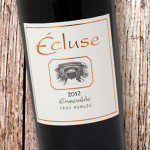 The 2012 Ensemble is a blend of 43% Cabernet Sauvignon, 27% Petit Verdot, 27% Merlot and 3% Malbec. It’s oaky, but pleasantly in balance with the fruit. On the palate you’ll find black currant with subtle but persistent dried herbal notes, a hint of cocoa, as well as a hard candy (peppermint) note through the finish. Perfectly balanced. 425 cases produced. $42.
The 2012 Ensemble is a blend of 43% Cabernet Sauvignon, 27% Petit Verdot, 27% Merlot and 3% Malbec. It’s oaky, but pleasantly in balance with the fruit. On the palate you’ll find black currant with subtle but persistent dried herbal notes, a hint of cocoa, as well as a hard candy (peppermint) note through the finish. Perfectly balanced. 425 cases produced. $42.
90 points
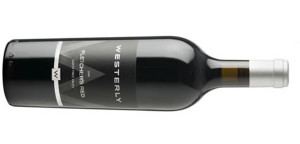 Westerly Wines, 2011 Santa Ynez Valley, Fletcher’s Red:
Westerly Wines, 2011 Santa Ynez Valley, Fletcher’s Red:
A blend of 35% Cabernet Sauvignon, 35% Malbec, 19% Merlot and 11% Petit Verdot, Fletcher’s Red displays terrifically aromatic black cherry fruit with nutmeg and clove accents. Full-bodied and so ripe it blurs the line between dry and sweet, there is no nuance here, just gobs of lip-smacking fruit. It may not be everyone’s cup of tea, but it will find some devoted fans. 275 cases produced. $75.
90 points
Cabernet Sauvignon (at least 75% Cabernet Sauvignon)
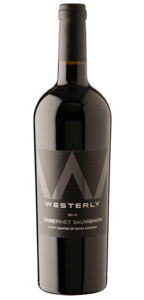 Westerly Wines, 2010 Happy Canyon of Santa Barbara, Cabernet Sauvignon:
Westerly Wines, 2010 Happy Canyon of Santa Barbara, Cabernet Sauvignon:
On the other hand, Westerly’s Cab is loaded with nuance. This blend of 95% Cabernet Sauvignon, and 4% Petit Verdot is (to my personal taste) a couple of steps above Fletcher’s Red. The nose is a complex mélange of mint, pencil shavings, cigar box and cassis. On the palate it’s layered, with firm but integrated tannins, fine structure, a good acid backbone, and a long mineral-spice finish. Enjoyable now and capable of extended aging. 801 cases produced. $60.
93 points
Bridlewood Estate, 2011 Paso Robles Cabernet Sauvignon:
Despite the fact that my notes on this wine could describe a Pinot Noir, it does possess varietal definition. The nose calls to mind black cherry and cola, while on the palate it’s more reminiscent of mulberry. Full bodied, silky and balanced, this is an elegant wine from nose to finish. It’s also widely available with 33,200 cases produced, and the best value of the group at just $15.
92 points.

Singer Cellars, 2012 Mt. George Vineyard, The Song, Coombsville, Napa Valley:
Though Singer Cellars is located in Petaluma, they source all their fruit from Napa. It’s a small, 600 case winery, producing wines of the highest caliber. All of their wines are characterized by lively acidity that Barry Singer describes as bringing out the range of tonality, which in organoleptic terms means that the acid helps broaden the spectrum of flavors. The Song 2012 is full of cherry and fresh black plum fruit, with a clean hint of celery, excellent structure, and a vibrancy that runs from first impression through the extraordinarily long finish. 118 cases produced. $42.
92 points.
Baus Family Vineyards, 2012 Sonoma County, Cabernet Sauvignon:
Vibrant cherry and rose petals with a hint of vanilla, soft tannins, tart on the palate with subtle herbal notes in the long finish. Subtle, but very elegant. 1,500 cases produced. $18.
91 points
Mud Pie, 2012, Mendocino Cabernet Sauvignon:
Nice balance of oak to fruit to spice. Menthol, cedar, basil, chewy tannins, well balanced. Needs a decade in the bottle to show its best. Black currant core with its typical tobacco scents. 2,500 cases produced. Good value. $16.
91 points
 Pedroncelli, Three Vineyards, 2012, Dry Creek Valley Cabernet Sauvignon:
Pedroncelli, Three Vineyards, 2012, Dry Creek Valley Cabernet Sauvignon:
Some very interesting aromatics but hard to pin down — cherry, bell pepper, floral tones, a hint of oak and several other scents tantalizingly out of reach. Pleasant lingering finish. 8,000 cases produced. $18.
90 points
